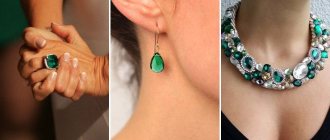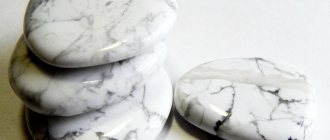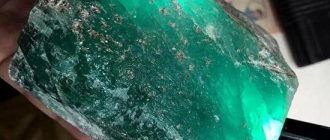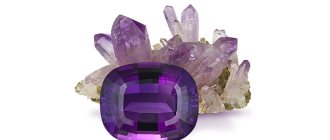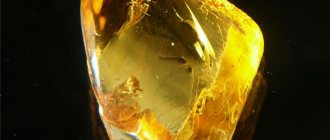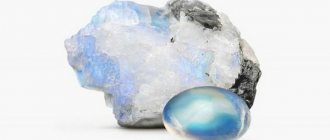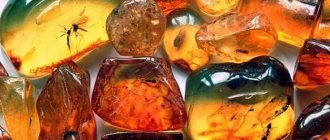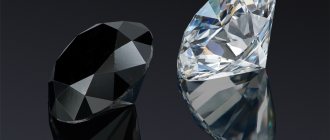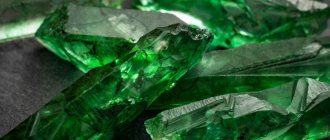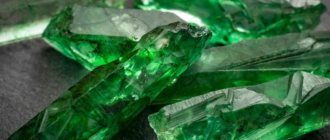Emerald
- a mineral, a transparent variety of beryl, colored with an admixture of Cr3+ or vanadium oxide with an admixture of iron oxide (South African emeralds) in a beautiful grass-green color. It is found in crystals and their intergrowths, usually grown into mica rock (mica), quartz or feldspar. The crystals are fissured, usually ranging in size from 2-5 mm to 0.5-2 cm, rarely larger. Emerald is a 1st class gemstone; large, defect-free stones of a thick, cold tone weighing over 5 carats are valued more than diamonds.
- Structure
- Properties
- Morphology
- Origin
- Application
- Classification
- Physical properties
- Optical properties
- Crystallographic properties
See also:
Emerald
– price and medicinal, magical properties
Physical properties and structure of diamond
STRUCTURE
Emerald belongs to the hexagonal system of the dihexanal-bipyramidal symmetry class. Impurities of chromium 1-2%, sodium, potassium, lithium, cesium, rubidium, iron, vanadium are noted. The main motif of the framework structure of beryl is represented by the six-wheel structures of the SiO4 ring - tetrahedra - Si6O18, connected to each other by BeO4 - tetrahedra in hexagonal columns with large channels inside such columns. These columns are connected to each other by BeO4 - tetrahedra and AlO6 - octahedra.
Black emerald
Such a stone was discovered in the mines of Colombia in the 20th century. However, this is not just a “dark emerald”. These are beryl crystals with a pronounced prism, but as if in a black dense jacket of carbonaceous substance. When they are cut crosswise, an “orange section” is revealed: emerald green transparent “slices” with cracks and inclusions are separated by black “lines” (films).
The variety was called "trapiche", that is, an oil press, which was used to produce sugar from cane. The black stone and the tool were very similar in appearance. They are used primarily as collection specimens, since the net yield of good quality cuts is negligible. It is of interest for unusual design solutions, for example, in the postmodern style.
Emerald classic is a stone of the same color. However, nature does not tolerate monotony, so gems of dark and light tones are found in the world. Samples from different deposits differ in the amount of jewelry raw materials; there are also unusual crystals, such as “trapiche”. Sometimes rare stones of a different composition are called emeralds to emphasize their individuality.
PROPERTIES
Emerald is a transparent variety of beryl colored grass-green by chromium oxide or vanadium oxide, sometimes mixed with iron oxide (South African emeralds). Emerald easily loses color at temperatures above 700 °C, but is resistant to acids and other reagents.
Natural emeralds are rarely flawless, they usually have cracks and splits, often dissected by a complex network of fine veins and fissures. Increased fragility is a characteristic feature of the stone: its hardness is 7.5-8 units on the Mohs scale (diamond has 10), in combination with thin transverse cracks, this makes it very sensitive to compression and heat.
The color distribution of emerald is uneven: usually the free end of the crystal is brighter colored than its base; there are also zonal crystals with a longitudinal change in color intensity (often with a brighter core) and with transverse alternation of light and dark green zones. In brightly colored stones, dichroism is noticeable even to the eye - a change in color from yellowish to bluish-green when the crystal is rotated.
Rainbow Gem
Another beautiful trade name that attracts buyers. However, like dioptase, it has nothing to do with beryl. Behind this name lies a polychrome (multi-colored) variety of tourmaline. The latter’s crystals are also elongated-prismatic, but in cross-section they show a triangle with seemingly broken sides. This results in 3 acute and 3 obtuse angles (the emerald has equally acute angles).
These are cheap samples, with colors and transparency that are not inferior to precious stones. The rainbow gem exhibits a rainbow-like transition, with colors ranging from emerald green (similar to Brazilian emerald) and light green to yellowish and pink. Suitable for fancy decorations, often with a minimum of metal. White gold and silver are used for the frame.
MORPHOLOGY
Emerald occurs in various species in nature. Brazilian emerald has a transparent green tint. Quite a rare name Trapiche, emeralds of this type have the shape of a carriage wheel with spokes. They are usually found in Colombia. Another type is called emerald - malachite or eurohit. The next variety of emerald is called Vilyuisk or Vesuvian. There are also copper emerald or dioptase, Ural or demantoid and nickel emeralds.
Copper stone
Copper emerald has absolutely nothing to do with precious stones. This is not beryl, but a mineral called dioptase, or ashirite. It is just as transparent, with a dark emerald green color. But “copper emerald” crystals have differences by which they can be easily recognized:
- these are not ordinary prisms with a hexagonal cross-section, but formed by rhombic faces;
- painted copper, not chrome;
- hardness is much lower.
It is already more difficult to distinguish a cut stone, since the properties of “copper” and chrome-beryllium gems are almost identical. But at high magnification, thin parallel or angled cracks can be seen inside the dioptase. This is due to the presence of perfect cleavage (that is, the ability to break into fragments with smooth surfaces upon impact).
The value of a “copper emerald” is low - orders of magnitude less than that of a real one. The best stones are suitable for inexpensive jewelry - pendants, earrings.
ORIGIN
Emeralds are formed by the interaction of acidic magma with host ultramafic igneous rocks, so their deposits are represented by greisenization zones. Occasionally, small emeralds are formed in the exocontacts of pegmatites.
In most deposits of the world, emerald is associated with phlogopite mica, formed as a result of greisenization - the impact of high-temperature aqueous solutions on ultrabasic rocks. As a result of this process, the original rocks, due to the feldspars of granites, are transformed into complex rocks containing quartz, light mica and often valuable ore minerals in the form of inclusions. The presence of greisen is a leading search indicator for deposits of rare metal ores and precious stones, including emerald.
The best quality emeralds are confined to hydrothermal veins located in carbonaceous shales. Colombian emeralds occur in low-temperature carbonate veinlets cutting through black bituminous limestones.
Pink emerald
This is the commercial name for pink beryl. Mineralogists do not classify it as an emerald, since it is colored not by chromium, but by manganese cations.
The story behind the name of the stone is unusual. This variety was discovered at the turn of the twentieth century. Several possible names were proposed, including the pink emerald of Afghanistan. However, the name of the American collector was chosen: now the official name of the stone is morganite. We call it in honor of the researcher sparrow.
This is a rare beautiful pink mineral with shades of peach, lilac, and cherry. The best raw materials come from Brazil and Madagascar. The cost of the stone is 2-2.5 times cheaper than chromium-beryl of similar quality. Suitable for white gold, platinum.
APPLICATION
The main use of emeralds is in the production of jewelry. The quality of jewelry stones is assessed in accordance with international requirements. The most valuable are bright green crystals with minor inclusions. Bright color is the main factor influencing the price. The world's largest processed emerald crystal, weighing 7.5 kg, was shown at the IV National Gem Fair of Brazil. Its owner is Lebanese Salim el Awar, who bought the gem in 1973 in the Brazilian village of Carnaiba, where there are over 6 thousand emerald mines. The largest emerald crystal was mined in 1974 in Brazil, its weight is 28 kg.
Emeralds are also used to create solid-state lasers.
Emerald – Be3Al2Si6O18
| Molecular weight | 537.50 g/mol |
| origin of name | from Greek “smáragdos”, Smaragd, tour. “zümrüd”, Persian-Arabic “zumurrud” |
| IMA status | valid |
Where are emeralds mined?
The oldest developments of emerald, known since the times of the Ancient World, are associated with the Arabian Peninsula. At that time it was the main source of jewelry stones. The Age of Discovery was marked by the discovery of South American deposits with high-quality raw materials.
The next date in the history of the mineral is the 30s of the 19th century, when the Ural emerald appeared. Its development began at the Malyshevsky mines. The 20th century saw the discovery of large deposits of jewelry crystals (Africa, India).
Now the gem is mined on five continents. But the main supplier of pure crystals is Colombia. Russia produces fewer stones, but almost all of them are of high quality.
Malyshevsky emeralds are widely known, among which there are both collector's items and examples of jewelry quality. A large number of gems come to the market from Panjshir, and Afghan ones are highly valued.
Several criteria are used to classify a mineral:
- color or shade (light, dark);
- deposit indicating the peculiarity of the raw material;
- origin - natural, artificial, imitation.
For the first time, a person grew synthetic emerald around the 50s of the 19th century, but this process was put into production 80 years later. Synthetics are used for inexpensive gold products. Faceted specimens are distinguished by their purity and richness of color, but have a blue tint.
The high cost of natural green gems leads to an increase in the number of imitations. The “Yakut emerald” - chrome diopside, which was discovered by geologists in Yakutia half a century ago, is an example of this. The color of the new mineral is indistinguishable from precious beryl. This sometimes made it possible to mislead buyers.
PHYSICAL PROPERTIES
| Mineral color | green, yellowish-green |
| Stroke color | white |
| Transparency | transparent, translucent |
| Shine | glass |
| Cleavage | Imperfect |
| Hardness (Mohs scale) | 7,5-8 |
| Kink | uneven, conchoidal |
| Strength | fragile |
| Density (measured) | 2.69 – 2.78 g/cm3 |
| Radioactivity (GRapi) | 0 |
Natural healer
The powerful energy of copper emerald has found application in lithotherapy. When heated, the mineral helps treat diseases of the upper respiratory tract, heart and blood vessels, relieves irritability, and calms the nervous system. Adherents of this treatment method believe that sessions with dioptase are indicated for pregnant women and patients who have suffered a heart attack or stroke. A pendant, brooch or amulet with a copper emerald is recommended to be worn at chest level by everyone who suffers from pathologies of the heart and blood vessels.
Dioptase improves the condition of respiratory tract diseases, including ailments affecting the trachea, throat and bronchi. In such a situation, it is advisable to wear an amulet with this mineral around the neck.
Traditional healers use ashirite powder to treat wounds that take a long time to heal. A brooch or pendant pinned to clothing helps ease breathing in people suffering from asthma. The healing properties of this mineral can relieve overexcitation and lift a person out of depression. To do this, you need to have a small crystal of a green healer with you.
OPTICAL PROPERTIES
| Type | single-axis (-) |
| Refractive indices | nω = 1.568 – 1.602 nε = 1.564 – 1.595 |
| Maximum birefringence | δ = 0.004 – 0.007 |
| Optical relief | moderate |
| Pleochroism | yellowish-green to bluish |
| Diffusion | excellent, 0.008 |
| Luminescence in ultraviolet radiation | not fluorescent |
Some historical facts
In the second half of the 18th century, merchant Ashir Zaripov discovered these stones in the mountains of Kazakhstan. He was sure that he had become the owner of real emeralds. The merchant sold them to an English officer, who at that time served in the Russian army. Several copies were brought to St. Petersburg. Here the find was named in honor of the merchant - the stone ashirite (asharite). Only eight years later, T. Lovitz, a Russian scientist, having carefully studied the mineral, found out that the find was not an emerald, but a copper silicate. Since then it has been called “pseudo-emerald”.
The famous mineralogist from France R. Gayuy gave the mineral its scientific name - dioptase, which consists of two Greek words. They can be translated as “observing through,” which characterize the translucency of the stone. Due to its resemblance to precious emerald, the mineral is used to make high-quality imitations of it.
During the reign of Catherine II, the dioptase stone was very popular at court. Any noble lady could boast of exquisite jewelry with inserts of raw crystals.
How to wear emerald jewelry correctly
Emerald jewelry is not recommended to be worn daily. It is better to wear them for special events. Gems will highlight an evening, business, romantic look, and will also look good with youth style (not large stones).
For young girls, elegant earrings or small, neat rings are suitable. For mature women - classic models of jewelry, rings. It is recommended to wear an emerald ring on the little finger, but you can wear it on any other finger.
Men will be able to emphasize their style and respectability with a massive ring made of silver or platinum, a tie clip, or cufflinks with emerald.
It would be nice to choose an emerald to match your eye color. It will highlight the rare green color of the iris and refresh the complexion.
The stone is framed in gold, platinum, silver. The silver frame better highlights the classic green color. Colorless stones (diamonds, rock crystal, cubic zirconia) will help complement the shine and beauty.
View this post on Instagram
Posted by Svetlana Gural (@svetlana__gural) Jun 1, 2022 at 12:55 PDT
View this post on Instagram
Publication from ? “Discount Gold” (@discount_zoloto) Jun 2, 2022 at 12:24 PDT
View this post on Instagram
Publication from VALTERA Jewelry House (@valtera_jewelry) June 1, 2019 at 3:00 PDT
Caring for stone and products
The stone is very fragile, so it is important to protect it from falling and scratches. In this regard, it is recommended to store emeralds separately from other jewelry in a box with soft upholstery.
You need to clean the stone in a soapy solution without adding chemicals. It is forbidden to use hard brushes; a soft cloth is sufficient for washing.
Do not expose the stone to high temperatures or direct sunlight. When cleaning the house, remove jewelry to avoid accidentally damaging it. Do not come into contact with decorative cosmetics.
Deposits and processing of precious stones
Mineral mining is carried out in many countries:
- Colombia;
- Brazil;
- Russia;
- Zambia;
- Egypt;
- New Granada;
- USA;
- Argentina;
- Zimbabwe;
- Austria;
- Norway;
- France;
- India;
- Spain;
- Italy;
- Germany;
- Kazakhstan;
- Switzerland;
- Afghanistan.
Rating of the best emeralds:
- Colombian emeralds are of the best quality. Even an unprocessed mineral has a high cost, because it is perfect.
- Brazilian emeralds are not far behind. The most famous stone mined in Brazil is the Bahia emerald.
- These two options compete with Russian gems. Emerald mining in Russia is carried out in the Urals at the Malyshevskoye deposit. Yakut (Siberian) gems are known, but in fact these are chrome diopsides.
- One of the inexpensive representatives includes Indian emerald.
The mineral is mined in mines using explosives, since clusters of emeralds in the ground are located at some depth. After the explosion, workers select pieces of rock and send them from the bottom of the mine to the top. The resulting material is sent to the factory, where workers select good samples.
The treatment is named after the mineral - emerald cut (step). It is applied to most crystals. Cloudy defective samples become cabochons.
When working with the mineral, jewelers carefully polish the edges in order to improve the reflective and refractive properties, obtaining faceted emeralds of various shapes (“Drop”, “Pear”, “Heart”, classic round, oval and others).
Watch a news video about a major discovery of a precious mineral:
Meaning and description of emerald
The gem belongs to the beryl group. The sibling of emerald is considered to be aquamarine, which has a similar color and chemical composition. The differences are in small impurities in the composition of aquamarine. Hence another name for the stone – green ice. The stone has shades of green ranging from pale, almost transparent, to rich herbaceous and dark colors.
Emerald is a symbol of justice, purity of thoughts, and rebirth. People called it “the heart of spring”, “the discoverer of truths”, “the protector of love”, because it is responsible for the heart chakra and helps in love relationships.
Natural emerald is one of the most expensive gems, even in its raw form. Cut gems are comparable in price to diamonds, rubies, and sapphires. For connoisseurs, the ideal stone weight is 6 carats; they are willing to pay considerable sums for it. Due to its rarity and exceptional characteristics, the gem is often counterfeited.
Methods have also been developed for growing artificial emeralds, which, in terms of their physical and chemical properties, are hardly distinguishable from natural ones. They are not fake. But since the supply of minerals may dry up, the sphere of artificial creation of precious stones is actively developing.
You can make an artificial emerald by placing a mixture of chemical elements (beryllium, aluminum, chromium, silicon, oxygen) in an autoclave with a pressure of 1200 atmospheres and a temperature of 500 degrees. This is the so-called hydrothermal method.
Zircon, glass ceramic, tourmaline, grossular, emerald quartz, alexandrite, cubic zirconia can be mistaken for emerald.
We recommend watching a video about the mineral:
Varieties and colors
The main color of the stone is green. But due to impurities, yellow, blue, pink and other shades may appear.
The stone has several varieties:
- Colombian - bright grassy green color, high quality.
- Trapiche is a variation of the previous option. The difference between Trapiche emeralds and Colombian emeralds is that 6 rays diverge from the center of the mineral.
- Emeralds from Zimbabwe are stones with a yellow tint, bright, clean, and of good quality.
- Zambian - stones with a blue or yellowish tint of high quality and good purity, the most beautiful.
- Brazilian - yellowish transparent gems of high quality and good purity.
- Ural - dark green minerals with a blue tint.
- South African - light green stones, cloudy, used for cabochons.
- Zimbabwean - small specimens with yellow spots.
- Yakut (Siberian) - called emeralds, but in fact they are chrome diopsides.
And more rare specimens:
- Red emerald is actually bixbite from the beryl group, very rare.
- Copper emerald is a transparent green mineral, very similar to dioptase.
- Pink emerald is a type of beryl (morganite, also known as sparrowstone), shades from pale pink to purple.
- Black emerald is essentially tourmaline with a predominance of iron.
The cut allows you to highlight the advantages of the gem. Cut with cabochon or emerald cut. Emerald cabochon is a cutting method that creates a resemblance to sapphire. Emerald cut - a stepped rectangular cut with truncated corners, having an octagonal outline
Emerald purity table:
| By cut | ||||
| Emeralds with cut | Cabochon | |||
| G1 | G2 | G3 | K1 | K2 |
| Clean, or with small cracks, inclusions, in different parts of the mineral. With sparkle and play. | Small cracks interspersed with other rocks, which create a condensation and network in some parts of the mineral. | Small cracks, interspersed with other rocks, with zones of turbidity, partly without shine or play. | Flaws from cracks, inclusions, with clouding in different parts of the rock. Transparent and translucent with glitter and play. | With an extensive network of cracks interspersed with cloudy areas inside the stone. Transparent and translucent without shine or play. |
| By color | ||||
| 1 | 2 | 3 | 4 | 5 |
| Dark green | Green | Medium green | Light green | Pale green |
How to distinguish from a fake
One of the replacements for the mineral is glass ceramic, a synthetic material synthesized in the laboratory. It can be passed off as natural stone. An ordinary person may not be able to distinguish an imitation from the original. But you can try:
- The original has a muted green color, the fake usually sparkles like a diamond.
- Of the defects, natural stone more often has cracks and veins, but the structure is uniform, while fake stone has a layered structure with bubbles or tubular inclusions.
- The original has clear, sharp edges, while the imitation has smoothed edges.
- When turned, a real mineral changes its hue from golden to bluish and vice versa.
- Natural stone is cool to the touch and takes a long time to gain heat when held in your hands.
- The fake is light in weight, unlike natural stone.
- In ultraviolet rays, a real stone does not change color, but a fake one glows.
- The original does not darken in water.
